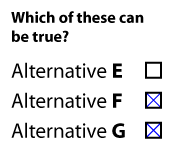Multiple choice
|
|
Multiple choice is a type of form to be filled out by checking one or more of the "choices" in a list. It is used in education (for testing), in elections (choose between multiple candidates, parties, or policies), in market research, and many more things. Its use in educational fields is sometimes contested due to some of its negative aspects, but it remains popular due to its great utility.
| Contents |
Pros
- Efficiency: Multiple choice questions allow a large amount of material to be tested in a small amount of time, whereas other tests may require the taker to use up a large amount of time to write out responses. Grading is also quicker, as most tests are now graded by machine (e.g. Scantron tests).
- Universal: Most subject matter can easily be broken down into multiple choice selections, thereby allowing easier standardization of testing practices.
- Neutrality: The taker is graded purely on his selection of one (or more) of the pre-determined responses, and the test doesn't allow the grader to introduce personal bias or misinterpretations.
- Response clarity: The responses are independent of the taker's ability to express himself clearly with language or handwriting. This eliminates a source of errors and makes grading simpler.
Cons
- Ambiguity: Failing to interpret information as the test maker intended can result in a "incorrect" response, even if the taker's response is valid. A free response test allows the test taker to make an argument for their viewpoint and potentially receive credit.
- No partial credit: Even if a student has some knowledge of a question, they receive no credit for knowing that information if they select the wrong answer. Free response questions may allow a taker to demonstrate their understanding of the subject and receive partial credit.
- Deductive reasoning: Test takers may be able to rule out answers (due to infeasibility), or even test each answer individually (especially when dealing with mathematics), thereby increasing the chance of providing a correct answer without actually knowing the subject matter. On the other hand, especially on mathematics tests, some answers are included simply for this reason, such as the giving an the equation 4x^2 + bx=3 and asking what b^2 equals- it cannot possibly be a negative answer.
Examples
In the equation <math>2x+3=4<math>, solve for x.
A) 4
B) 10
C) 0.5
D) 1.5
E) 8
Famous multiple choice tests
- SAT (also free response)
- AP (also free response)
- PSAT (also free response)
- GRE (also free response)
- MCAT (also has a free response component)
- LSAT (also has a free response component)


